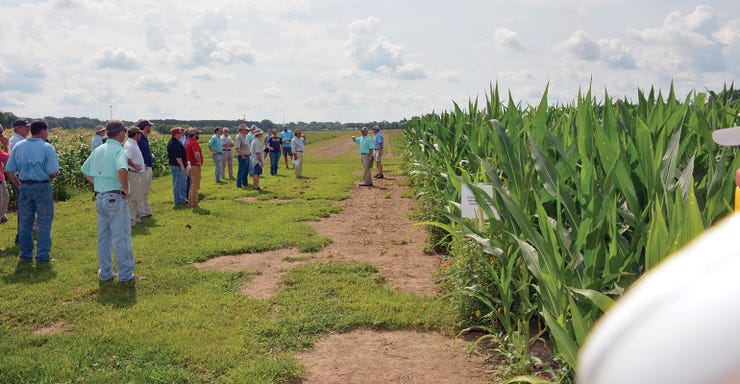
The annual West Tennessee Research and Education Center weed tour highlighted a mix of the latest and longstanding weed control products along with some systems and techniques necessary to manage tough weeds.
“We’re looking at herbicides and things like cover crops, nozzles and surfactants, and the whole gamut of what you’ve got to put together to get a good weed control program,” said University of Tennessee Institute of Agriculture weed scientist Larry Steckel, following the tour on the Jackson, Tenn., research farm.
“Integrating things like cover crops with herbicides is one of the big things we’re looking at here. Some thought and a little bit of strategy are required in these systems,” he said.

Weed Plots
Grassy Weed Issues
Grassy weeds have been a particular problem in cover crop systems this year. “We’ve seen a lack of grassy weed control in a lot of west Tennessee fields. Extension has received a lot of calls and folks are trying to get some answers to help manage a lot of these grassy weeds, things like goosegrass, the barnyardgrass complex and johnsongrass, which glyphosate is really scuffling right now to control.”
He’s worked with graduate student Clay Perkins to come up with answers to help manage grassy weeds.
One thing they recommend is not to depend on cover crops alone for weed control.
“We have a lot of demonstrations out here that show very clearly that a cover crop will give you anywhere from 40 percent to 60 percent weed control for three to four weeks, depending on how robust the cover is. But if that’s all you did, you’re going to have a grownup weedy mess,” Steckel said.
“We’ve got to integrate other weed management technologies, and herbicides are the main thing, of course.”
New Combos
Part of the research work at the Jackson station has been testing herbicides to find the best fit with cover crops. “Some of it depends on how robust the cover crop is,” Steckel said. “Some of the more water-soluble herbicides seem to work a little better if the stand is thicker.”
He said a poor growing season for cover crops, precipitated by a hard winter, illustrates the point. “We had a hard winter getting the cover crops started and with a thinner stand all of them (tested herbicides) work well. But herbicides are needed in a cover crop system.”
Steckel also discussed some new herbicide options, but not new chemistry.
“We’re testing several new options, new pre-mixes. Some look really, really good.”
He mentioned Syngenta’s Tavion, a pre-mix of Dual Magnum and XtendiMax, that looks promising. A pre-emergent from FMC, a pre-mix of Anthem Max and Spartan, “has been very impressive, giving residual control on pigweed in soybean. I’ve been very impressed with it.
“So those two come to mind right off, but there are others as well. UPL had a couple of pre-mixes, and one that looks good is a pre-mix of glufosinate or Interline and Dual Magnum. I call it Intermoc. That’s one that looked pretty interesting.”

Registration
Managing Drift
During a stop at one of the tour stations, Steckel pointed out cotton and soybean plots with different herbicide tolerant traits.
“We are an acid test here,” he said, “because we’ve got Enlist cotton within 10 feet of Xtend cotton within 15 feet of Enlist soybeans. All of these technologies are in very close proximity to each other. We had almost no drift events. And that’s saying a lot because we do a lot of spraying.”
He qualified the statement a bit. “We walk these on by hand boom. So, it’s not like a commercial applicator and a big rig. Still, in years past we’ve had more drift issues. We’ve done better this year. In the end, fewer drift issues to date may be due to the unseasonably cool spell when many of these applications were made two weeks ago.
“But we didn’t have any calls the last two years at this time of year either. So, I have my fingers crossed that we’ll stay quiet into July. The jury’s still out on that.”
He said producers had started spraying only in the 10 days to two weeks prior to the weed tour. “So, if we’re going to have problems, the phone will start ringing in the next 10 days.”
He said a few calls had come in on tank contamination issues.
“We’ve had some of that, but we have it every year. Sprayers aren’t cleaned out well, folks get so busy and have such limited time to spray that invariably some of that happens. We’ve heard a little bit of that, but nothing out of the ordinary.”
About the Author(s)
You May Also Like






